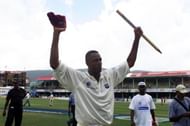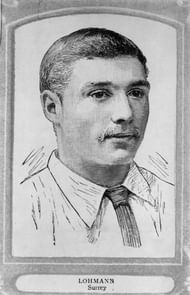The one-day international format has seen plenty of ‘containing’ spells that have contributed to some great victories, more so in the twentieth century. It is not easy to dry up the runs in the limited-overs format where the batsmen will always be on the lookout for runs.
This is more visible in the modern game which clearly favours the batsmen. Economies and strike rates have risen dramatically over the years, especially since the advent of Twenty20 cricket. Previously unimaginable scores of 400 in ODIs have been breached an ample number of times now.
There have been some outstanding spells over history, which have been so incredible that the bowler has managed to take more wickets than the number of runs he conceded. With the modern era favouring batting, it is tough to imagine any additions to this list in the foreseeable future.
#4 Stuart Binny (4.4-2-4-6)

In June 2014, India toured Bangladesh for a three-match ODI series and won the rain-curtailed first ODI, thanks to the Duckworth-Lewis method.
In the second ODI at Dhaka, Indians strode in to bat first but a five-wicket haul from Taskin Ahmed, coupled with fine support from the other Bangladeshi bowlers, saw the visitors bundle out for just 105. They might not have breached the three-digit figure had it not been for Umesh Yadav's quickfire 17 at the end.
It looked like Bangladesh had the game in their pocket but it was not to be, much to the dismay of the passionate Bangladesh fans. After Mohit Sharma dismissed both openers cheaply, Mohammed Mithun and Mushfiqur Rahman stabilized the innings with a 31-run partnership.
Enters Stuart Binny. From 44/2, the Bangladeshis bundled out for a mere 58. Binny gave away 4 runs in his 4.4 overs and bagged 6 wickets!
The 28 deliveries that he bowled had 26 dot balls, which included the 6 wickets of course. This astonishing spell saw Binny not only win the man of the match award but also etch his name in the history books.
#3 Courtney Walsh (4.3-3-1-5)

Back in 1986, the West Indies were at the top of their game. Sri Lanka, on the other hand, were still getting accustomed to international cricket. In the Champions Trophy, the two island nations squared off in a game that was naturally expected to be a West Indian annihilation.
Sri Lanka had lost comprehensively to India and Pakistan prior to this game, and the West Indians had trounced the same two teams.
Richie Richardson's century saw the West Indies amass 248 runs, which was a daunting target for the Lankans, to say the least. The West Indies bowling attack had players of the highest calibre, such as Curtly Ambrose, Malcolm Marshall and Joel Garner.
Courtney Walsh, who was in the early stages of his career, played second fiddle to these bowlers and would come into bowl as the fifth bowler more often than not. This, of course, did change in due course of time as Walsh rose to become West Indies' prime fast bowler.
In the run chase, the Sri Lankans were struggling at 50 for 5 and Walsh was then given the ball to finish things off. Walsh exceeded expectations by bowling a spell which to this day is the cheapest five-wicket ODI haul in the game's vast history.
He cleaned up the tail in his 4.3 overs while giving away a single run. The Sri Lankans were bundled out for 55 runs and Walsh was handed the man of the match award for his lethal spell of 4.3-3-1-5.
#2 George Lohmann (9.4-5-7-8)

We have to go back to the nineteenth century for this one! 1865 born Englishman George Lohmann, to this day, boasts the best bowling average and strike rate among bowlers with more than 15 wickets. Though many credit his astounding figures to the fact that pre-1900 pitches were sticky and bowling heavens, Lohmann's figures are significantly better than others in his era.
Lohmann's story is a sad one, as he succumbed to a nine-year battle with tuberculosis at the age of 36. He could play only 18 Test matches owing to his health issues, but he managed to bag an incredible 112 wickets in that period with a monstrous average of 10.75 and a strike rate of 34.1.
His greatest performance came in 1896 against South Africa. England put on a modest total of 185. South Africa replied with a measly 93, as Lohmann picked up 7 wickets for 38 runs.
What made this performance even more special is the fact that all seven of his wickets were out bowled. England then set a virtually impossible target of 319 for the South Africans, but the Englishmen batted long enough to make it almost inevitable that the match would extend into the third day.
Lohmann had other plans. He ran through the South African order and picked up eight wickets to finish the match off on day two. He gave away a miserly seven runs in this spell and got five scalps by knocking their wicket over.
His other three scalps were skilful enough to get bat to the ball but found fielders in the process. As if the fifteen wicket hall wasn't enough, Lohmann took 9 wickets for 28 runs in an innings in the subsequent Test match.
#1 Phil Simmons (10-8-3-4)

In the eighth match of the Benson and Hedges world series in Australia, Phil Simmons bowled an unbelievable spell that, to this day, remains the most economical spell in the history of ODI cricket.
Pakistan bowled well to restrict the West Indies to 215. With players like Curtly Ambrose and Patrick Patterson expected to wreak havoc for the West Indies, it was shocking to see Phil Simmons create history. Simmons was known for his hard-hitting batting style and his medium pace bowling was relatively unknown.
Pakistan were bowled out for 81 in their chase, and they took did so at a sluggish run rate of 1.68. Simmons, incredibly, bowled eight maidens in his ten overs and took four wickets too. He gave away just three runs in his sixty deliveries and claimed the man of the match award for this spectacular showing with the ball.
It has been over 25 years and Simmons's record still stands. Considering the fact that the modern game supports the batsman, it is likely that his will hold on to this record for the foreseeable future.
Honourable mentions (for almost making the cut)

Anil Kumble (3.1-1-5-5)
This spell just had to somehow make it to this list owing to the fact that it was in a Twenty20 game. The shortest format of the game has known to be very unkind to its bowlers. Getting more wickets than runs conceded is hard to imagine, and Kumble almost pulled it off.
Defending champions Rajasthan Royals were chasing a target of 134 set by the Royal Challengers Bangalore in the second match of the 2009 IPL season as Cape Town was heavily assisting the bowlers that day.
Rahul Dravid played brilliantly for his 66 and guided his team to 134 with help from newly appointed captain Kevin Pietersen. In fact, no-one else from the Bangalore side could even reach double digits.
In the chase, Rajasthan were struggling at 47-5 in 11 overs. Kumble put an end to their misery by cleaning the house and laying claim to all remaining five wickets to bowl the Royals out for 58.
Kumble gave away just five runs in his five-for. His figures of 3.1-1-5-5 are unreal for an IPL spell and is one of the finest spells the ten-year-old league has witnessed.
Sunil Joshi (10-6-6-5)
In September 1999, Sunil Joshi bowled a spell that he will always be remembered for. It was the LG cup, a quadrangular tournament featuring India, South Africa, Kenya and Zimbabwe. This was the second match of the tournament and the South Africans fielded a formidable side, while India were without captain Azharuddin and ace spinner Anil Kumble.
This gave Sunil Joshi, who was generally sidelined because of Kumble, a chance to feature in the playing eleven.
The South Africans opted to bat first so that they wouldn't face the wrath of the Indian spinners on a pitch subjected to wear and tear. There was no respite for them, however.
Sunil Joshi bowled beautifully and bagged five scalps while giving away just 6 runs in his full quota of 10 overs. To this day, his economy of 0.60 remains the fourth most economical spell by anyone completing his full quota of overs. He deservedly got the man of the match laurel for this exemplary performance that defined his career.
Follow IPL Auction 2025 Live Updates, News & Biddings at Sportskeeda. Get the fastest updates on Mega-Auction and cricket news
